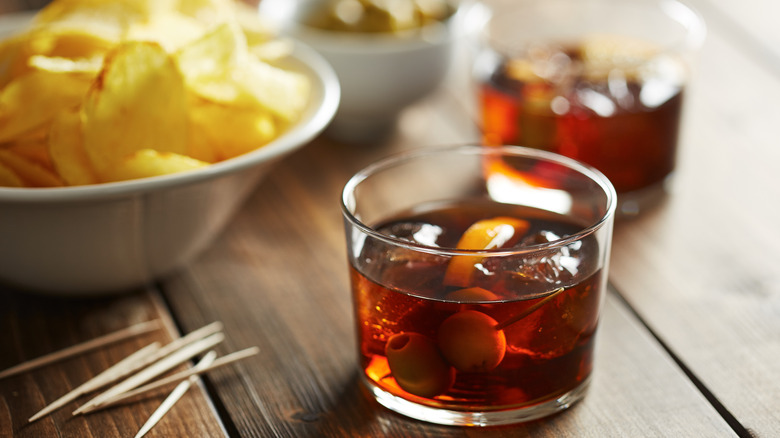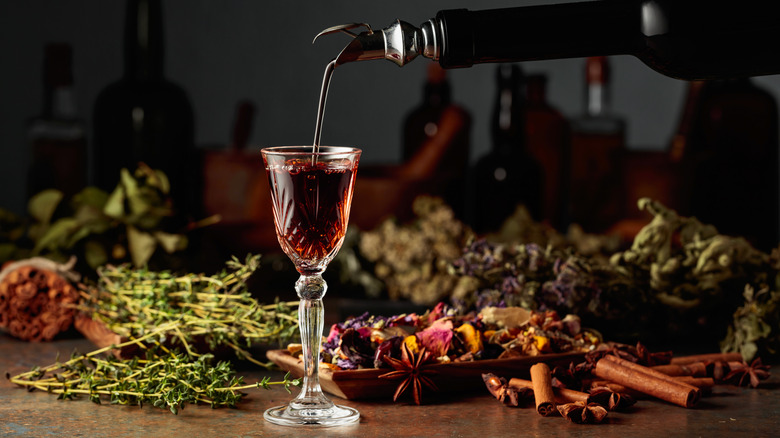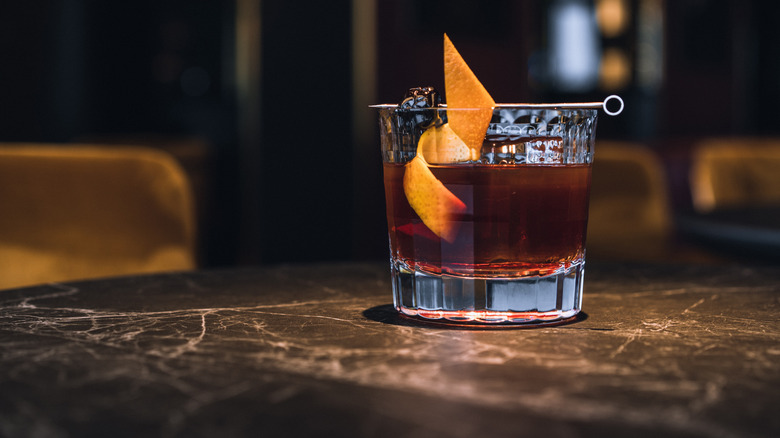What's The Difference Between Aperitifs And Digestifs?
Fans of tasty booze will attest; there's more to drinking than just getting a buzz. Sampling new flavors, mingling liqueurs with foods, and savoring a communal experience are all reasons to pour a glass. Especially in Europe, such drinking customs have been around for centuries, and take on established contexts like the aperitif and digestif.
At their most fundamental, the difference in the two drink categories seems clear: aperitifs come prior to a meal, and digestifs afterwards. Even their etymology clearly evinces the details — aperitif stems from the Latin verb meaning "to open", while digestif simply means "digestive in French. However, despite such concise delineations, there's lots of complexity.
The range of aperitifs is expansive; many liqueurs, wines and cocktails are suitable offerings, but they all share qualities of low-alcohol and light refreshment. Digestifs lean into boozy and bold territory, but similarly present lots of options. So, while lots of beverages fit into either categorization, there are some clear distinctions to each style, meanings there are some differences to unpack.
What is an aperitif?
Popular in France, Italy, and other areas of Europe, an aperitif is a pre-dinner drink that's also a beautiful ritual. As the opening offering to guests and first sip of booze during an evening meal, it's a flavorful start to a dining experience. Typically, the aperitif's palate leans dry, a little fruity, and low in alcohol. It's served cold in a small size — enough to tingle the senses, and enhance appetite, without overwhelming in flavor and strength.
The possibilities are wide-ranging; it can be a commonplace drink like a dry white wine, or perhaps a gin and tonic served in a balloon shaped glass. It can also be a highly aromatic fortified wine or liqueur. Dry vermouths and sherries are excellent candidates that pack crisp and satiated flavors. And, there are lots of fascinating bitter liqueurs to explore, from the renowned Italian Campari, to quinine-flavored French Lillet, aromatized and fortified Dubonnet, and artichoke-infused Cynar.
Such liqueurs may be served straight, but oftentimes they're crafted into unfussy cocktails, too. Italian aperitivo drinks like the aperol spritz, negroni, and lesser-known bicicletta and americano are becoming stalwarts on American menus, but many forget they emerge from aperitif contexts. Such delicious Italian cocktails often reassemble aperitif foundations in mixed formats showcasing the malleable — and ever evolving — nature of this pre-dinner drink.
What is a digestif?
With its post-dinner context, the digestif is a stark contrast to the aperitif. It's a slow-sipper also full of flavor, but meant for languorous imbibing, as opposed to the aperitif's zippy nature. More wide-ranging in nature, it's enjoyed in a greater variety of European cultures, like Germany, the Czech Republic, and northern Europe, in addition to Spain, Italy and France.
Typically, it's both high in alcohol, and has more sugar, although the sweetness is accompanied with bold notes of spice, herbal, and barrel flavors. It's not a dessert-like conclusion to a meal, but rather a final lasting impression, meant to aid digestion. Many digestifs have similar production method to aperitifs, but resulting in a more intense palate. Fortified wines like sweeter varieties of sherry and vermouth as well as port, and madeira are common selections. Other grape-based possibilities include regional variations of brandy — especially in a barrel-aged format. And, other aged liquors like whiskey, cognac, and aged tequilas can be post-dinner classics.
Bitter and herbal liqueurs also make quintessential digestifs. Unique spirits like Chartreuse, Fernet-Branca, varying Italian amaros, aquavit and other regional creations have historically been crafted for digestif applications. Some — like Cynar and Averna — possess a palate that can also sway aperitif territory. Nevertheless, digestifs are marked by a stiffer, more robust nature that makes them easy to differentiate as few would enjoy a pour of a bold and biting liquor before a meal.
Aperitifs and digestifs stem from different historical contexts
Despite their similar nature, the two drink categories stem from distinct contexts centuries apart. Digestifs have an older tradition, with people enjoying post-dining beverages since Ancient Greek times. In distilled form, such alcohols crafted for medicinal aim rather than enjoyment, took off in the Middle Ages. Liqueurs like Chartreuse trace as far back as 1605, and had elixir-like qualities.
Although many health effects with such pungent spirits were unfounded, there was an intention with the flavor palate. It's believed bitter and bold notes were used to impart a toxin-like physiological response to the body, which will thereby enhance digestion to quickly process the liquid. Such aromatic potions were confined to pharmacy shelves until the 18th century, when diners discovered their delightful taste and experience after a meal. And so, the class expanded in variety, and became an established ritual for centuries.
Conversely, the concept of aperitifs is a more newfound creation, first emerging alongside a burgeoning Italian cafe culture at the end of the 18th century. At the time, drinking aromatic wines prior to a meal became trendy, hence the rapid development of such a beverage type. Although flavored wines had already been around — and similarly intertwined with medicinal uses — they didn't exist in a specific consumption context. Nevertheless, the aperitif caught wind, and it hasn't faded since.
Digestifs are more varied than aperitifs
There's an ample selection for both the aperitif or digestif. So, it's not too hard to find a specific beverage to satisfy the context. However, there are characteristics for traditional candidates for each respective category, and digestifs offer a larger variety of regional renditions.
Since aperitif culture is mainly confined to France and Italy, standalone liqueurs and spirits are less expansive– although the two countries do produce an astonishing range. The possibilities further multiply as the liquors form the base of many aperitif cocktails. Drinks like gimlets, martinis, plus sherry and lillet-based spritzes present an opportunity for creative aperitif imbibing — just remember to keep it delicate, and not overly boozy.
Conversely, digestifs also encompass spirits like Scandinavian aquavit, Czech herbal creations like becherovka, and Hungary's eucalyptus-tasting unicum. Add in the fact that nearly any barrel-aged spirit — and its use in a cocktail — can be a digestif, and the selection is mind-boggling. Everything from whiskey-based cocktails like the manhattan or a great-tasting old-fashioned, to a coffee-booze creation, and bitter amaro drinks are fit for the role. Plus, sweet liqueurs like maraschino and limoncello are also post-dinner classics, adding to the many options. So, sip on such a stiff offering, perhaps with a cheese board served after dinner in France, and take in the complexities — there are a whole lot of incredible flavors to untangle.




